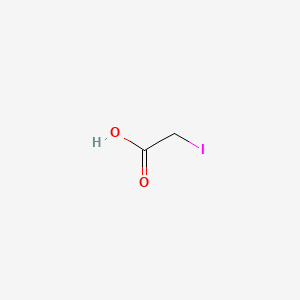| MeSH term | MeSH ID | Detail |
|---|---|---|
| Brain Edema | D001929 | 20 associated lipids |
| Blood Platelet Disorders | D001791 | 12 associated lipids |
| Blindness | D001766 | 6 associated lipids |
| Arthritis, Experimental | D001169 | 24 associated lipids |
Iodoacetic acid
Iodoacetic acid is a lipid of Fatty Acyls (FA) class. Iodoacetic acid is associated with abnormalities such as Photoreceptor degeneration and Post MI. The involved functions are known as Hypoxia, Glycolysis, Metabolic Inhibition, Oxidation and PTPS activity. Iodoacetic acid often locates in Extracellular, Muscle, Mitochondria, Cytoplasmic matrix and Tissue membrane. The associated genes with Iodoacetic acid are SLC33A1 gene, GTF2I gene, Mutant Proteins, TRIM33 gene and oxytocin, 1-desamino-(O-Et-Tyr)(2)-.
Cross Reference
Introduction
To understand associated biological information of Iodoacetic acid, we collected biological information of abnormalities, associated pathways, cellular/molecular locations, biological functions, related genes/proteins, lipids and common seen animal/experimental models with organized paragraphs from literatures.
What diseases are associated with Iodoacetic acid?
Iodoacetic acid is suspected in Photoreceptor degeneration, Post MI and other diseases in descending order of the highest number of associated sentences.
Related references are mostly published in these journals:
| Disease | Cross reference | Weighted score | Related literature |
|---|
Possible diseases from mapped MeSH terms on references
We collected disease MeSH terms mapped to the references associated with Iodoacetic acid
PubChem Associated disorders and diseases
What pathways are associated with Iodoacetic acid
There are no associated biomedical information in the current reference collection.
PubChem Biomolecular Interactions and Pathways
Link to PubChem Biomolecular Interactions and PathwaysWhat cellular locations are associated with Iodoacetic acid?
Visualization in cellular structure
Associated locations are in red color. Not associated locations are in black.
Related references are published most in these journals:
| Location | Cross reference | Weighted score | Related literatures |
|---|
What functions are associated with Iodoacetic acid?
Related references are published most in these journals:
| Function | Cross reference | Weighted score | Related literatures |
|---|
What lipids are associated with Iodoacetic acid?
There are no associated biomedical information in the current reference collection.
What genes are associated with Iodoacetic acid?
Related references are published most in these journals:
| Gene | Cross reference | Weighted score | Related literatures |
|---|
What common seen animal models are associated with Iodoacetic acid?
There are no associated biomedical information in the current reference collection.
NCBI Entrez Crosslinks
All references with Iodoacetic acid
Download all related citations| Authors | Title | Published | Journal | PubMed Link |
|---|---|---|---|---|
| Wilson CG et al. | Aggrecanolysis and in vitro matrix degradation in the immature bovine meniscus: mechanisms and functional implications. | 2009 | Arthritis Res. Ther. | pmid:19919704 |
| Jinka R et al. | Purification and characterization of cysteine protease from germinating cotyledons of horse gram. | 2009 | BMC Biochem. | pmid:19919695 |
| Harvey VL et al. | A Selective Role for alpha3 Subunit Glycine Receptors in Inflammatory Pain. | 2009 | Front Mol Neurosci | pmid:19915732 |
| Lee SJ et al. | Alterations in membrane transport function and cell viability induced by ATP depletion in primary cultured rabbit renal proximal tubular cells. | 2009 | Korean J. Physiol. Pharmacol. | pmid:19885021 |
| Galli GL et al. | Ca2+ cycling in cardiomyocytes from a high-performance reptile, the varanid lizard (Varanus exanthematicus). | 2009 | Am. J. Physiol. Regul. Integr. Comp. Physiol. | pmid:19812356 |
| Bar-Yehuda S et al. | Induction of an antiinflammatory effect and prevention of cartilage damage in rat knee osteoarthritis by CF101 treatment. | 2009 | Arthritis Rheum. | pmid:19790055 |
| Tolonen AC et al. | Targeted gene inactivation in Clostridium phytofermentans shows that cellulose degradation requires the family 9 hydrolase Cphy3367. | 2009 | Mol. Microbiol. | pmid:19775243 |
| Castillo-Romero A et al. | Participation of actin on Giardia lamblia growth and encystation. | 2009 | PLoS ONE | pmid:19774081 |
| Lur G et al. | Ribosome-free terminals of rough ER allow formation of STIM1 puncta and segregation of STIM1 from IP(3) receptors. | 2009 | Curr. Biol. | pmid:19765991 |
| Lassiter C et al. | HIV-1 transgene expression in rats causes oxidant stress and alveolar epithelial barrier dysfunction. | 2009 | AIDS Res Ther | pmid:19193217 |
| Miao J et al. | 3-Carboxy-methyl-1,3-benzimidazolium-1-acetate monohydrate. | 2009 | Acta Crystallogr Sect E Struct Rep Online | pmid:21583676 |
| Zhao R et al. | Aqua-bis(2-iodo-acetato-κO)(1,10-phenanthroline-κN,N')copper(II). | 2009 | Acta Crystallogr Sect E Struct Rep Online | pmid:21581830 |
| Clements KM et al. | Cellular and histopathological changes in the infrapatellar fat pad in the monoiodoacetate model of osteoarthritis pain. | 2009 | Osteoarthr. Cartil. | pmid:19114312 |
| Santos-Rosa H et al. | Histone H3 tail clipping regulates gene expression. | 2009 | Nat. Struct. Mol. Biol. | pmid:19079264 |
| Devalaraja-Narashimha K and Padanilam BJ | PARP-1 inhibits glycolysis in ischemic kidneys. | 2009 | J. Am. Soc. Nephrol. | pmid:19056868 |
| Miao J et al. | 1,3-Bis(carboxy-meth-yl)imidazolium triiodide 1-carboxyl-atomethyl-3-carboxy-methyl-imidazolium. | 2009 | Acta Crystallogr Sect E Struct Rep Online | pmid:21583487 |
| Xiang T et al. | Localization and quantitation of free sulfhydryl in recombinant monoclonal antibodies by differential labeling with 12C and 13C iodoacetic acid and LC-MS analysis. | 2009 | Anal. Chem. | pmid:19722496 |
| Chumsae C et al. | Identification and localization of unpaired cysteine residues in monoclonal antibodies by fluorescence labeling and mass spectrometry. | 2009 | Anal. Chem. | pmid:19572546 |
| Baragi VM et al. | A new class of potent matrix metalloproteinase 13 inhibitors for potential treatment of osteoarthritis: Evidence of histologic and clinical efficacy without musculoskeletal toxicity in rat models. | 2009 | Arthritis Rheum. | pmid:19565489 |
| Suna H et al. | Dysideamine, a new sesquiterpene aminoquinone, protects hippocampal neuronal cells against iodoacetic acid-induced cell death. | 2009 | Bioorg. Med. Chem. | pmid:19414266 |
